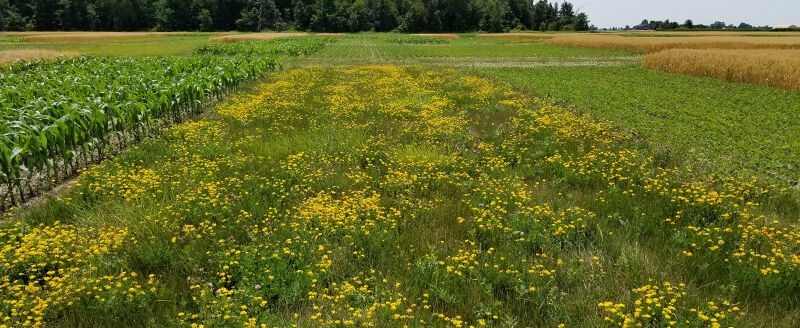High nitrogen prices make it especially important to consider frost seeding legumes this winter, said University of Missouri Extension state forage specialist Craig Roberts.
“2022 is different because fertilizer costs have tripled,” Roberts said. “Consider legumes as nearly free fertilizer.”
Frost seeding, a method of broadcasting seeds onto frozen pastures, improves poor pastures at a low cost, he said. Seeds work their way into the soil and germinate as the ground freezes and thaws.
Frost seeding requires less fuel, labor and equipment than other methods, Roberts said. It works at a time when heavy equipment could rut and compact wet fields.
Most importantly, nitrogen-fixed legumes can be an alternative to fertilizer.
Red clover, white clover and annual lespedeza are the top three legumes recommended for frost seeding in Missouri, Roberts said. Other legumes include alfalfa, birdsfoot trefoil, hairy vetch and sunn hemp. These should be seeded later in the year.
Legumes fix nitrogen
Legume root nodules fix nitrogen from the air. Not all legumes are created equal when it comes to fixing nitrogen, said Roberts. In a typical year, fixed nitrogen replaces 25 to 75 pounds per acre of fertilizer.
Legumes improve digestibility
Grazing cows like legumes. Legumes improve digestibility with higher crude protein content and higher mineral content, especially calcium and magnesium.
Animal performance improves with legumes
Studies show that animal performance and weight gain improve with legumes, especially clovers.
Legumes extend the grazing season by growing better in late spring and summer, when fescue grows slowly or not at all. Cool-season grasses get two-thirds of their growth in spring and one-third in fall. Annual lespedeza fills this gap, known as the “summer slump.”
There are veterinary benefits as well. Adding red clover to common tall fescue fields helps prevent some animal health issues, Roberts said. Adding legumes dilutes fescue toxicosis. More than 90% of Missouri fields contain toxic Kentucky 31 tall fescue. Fescue toxicosis causes vasoconstriction, a narrowing of blood vessels. In summer, this causes heat to build up in an animal’s core body. In winter, blood does not flow to extremities and hooves fall off. Red clover contains compounds that open blood flow,.reducing vasoconstriction
When to frost seed in Missouri
Roberts said frost seeding is easy for clover and annual lespedeza. Most producers use a handheld whirlybird or a whirlybird attached to a four-wheeler.
There are several advantages of doing this on the snow, Roberts said. It is easy to see where seeds were spread, and there is less chance of rutting or compaction of wet soils since the ground is frozen.
In most of Missouri, broadcast in mid-February when there is snow or heavy frost. Frost seed in late January in southern regions or late February in northern counties.
Roberts specifically recommends not frost seeding alfalfa and birdsfoot trefoil in January or February. If seeded then, it is possible that the seed will germinate and emerge before an ice storm. Roberts said he does not recommend interseeding birdsfoot trefoil because it has poor seedling vigor in Missouri.
Seeds need to contact soil
Seeds need the freeze-and-thaw action for good soil contact and to pull the seed to the soil’s top layer, Roberts said.
The best contact occurs on exposed soil. Plant residue can prevent seeds from reaching soil. The hoofing action of cattle can help work seeds into the soil.
Apply little to no nitrogen in spring
Legume seedlings need time to grow without competition for light and nutrients from grass canopies, so apply little or no nitrogen in spring. Adding more nitrogen fertilizer decreases the amount and size of nodules.
Wait until fall when root systems are strong. Graze or clip frost-seeded pastures in spring and summer to allow light to reach seedlings.
A four-year study by MU researchers, “Nitrogen Fertilization Rates Influence Stockpiled Tall Fescue Forage Through Winter,” shows that nitrogen increases grass competition and blocks light penetration significantly in red clover. Read the full report at acsess.onlinelibrary.wiley.com/doi/abs/10.2135/cropsci2016.02.0097.
How much seed?
Roberts recommends the MU Extension publication “Seeding Rates, Dates and Depths for Common Missouri Forages” at extension.missouri.edu/p/G4652 to determine seeding rates.
For more information, see “Inter-Seeding Legumes in Pastures Can Offset High Nitrogen Prices” in the MU Integrated Pest & Crop Management newsletter, or watch an MU Livestock and Forages Town Hall video at youtu.be/zkYQo251xDQ.
Roberts also recommends pasture renovation workshops from the Alliance for Grassland Renewal. See GrasslandRenewal.org/workshops.




